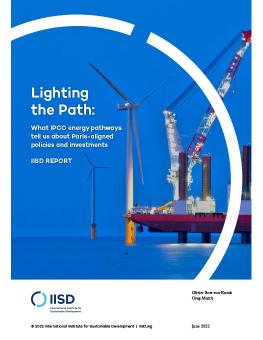
Lighting the Path: What IPCC energy pathways tell us about Paris-aligned policies and investments
This report outlines key implications for governments and investors aiming to align their policies and investments with the 1.5°C target of the Paris Agreement, based on different energy pathways published by the Intergovernmental Panel on Climate Change (IPCC) in its Sixth Assessment Report, published in April 2022.
-
No new oil and gas fields should be developed, and no exploration conducted in order to limit warming to 1.5°C
-
By 2030, wind and solar deployment needs to be double the forecasted estimates under current policies; additional supportive policies are necessary to enable this growth.
-
There is an urgent need to plug the yearly USD 450 billion investment gap for wind and solar.
This report shows that significant structural changes are required in the energy sector to align with pathways limiting warming to 1.5°C. The pathways consistent with the IPCC’s assessment of feasible and sustainable deployment of Carbon Dioxide Removal and Carbon Capture and Storage technologies leave no room for delayed action. The oil and gas phase-out timelines presented in this report constitute the ambition level consistent with the best estimates of the current and future capacity of mitigation technologies. Accordingly, this report presents the key implications for governments and financial institutions aiming to align their policies and investments with feasible 1.5°C pathways. Its recommendations are designed to guide the understanding of the Paris alignment, consistent with the IPCC findings, and should inform plans to strengthen and amplify policy interventions.
Participating experts
You might also be interested in
Carbon Minefields: Oil and gas exploration surging to pre-Covid levels
Oil and gas exploration is booming despite an agreement at last year’s COP 28 climate summit to transition away from fossil fuels.
July Edition | Carbon Minefields Oil and Gas Exploration Monitor
In June 2024, six governments issued 18 oil and gas exploration licences with embodied emissions of 14.7 MtCO2, led by Russia and China.
Global Dialogue on Border Carbon Adjustments: The case of Brazil
This report consolidates, analyzes, and presents the views and perspectives of stakeholders from Brazil on border carbon adjustment (BCA) schemes to contribute to the global debate on BCA good practices.
Border Carbon Adjustments: Trinidad and Tobago country report
This report consolidates, analyzes, and presents views and perspectives of stakeholders from Trinidad and Tobago on border carbon adjustment (BCA) schemes to contribute to the global debate on BCA good practices.